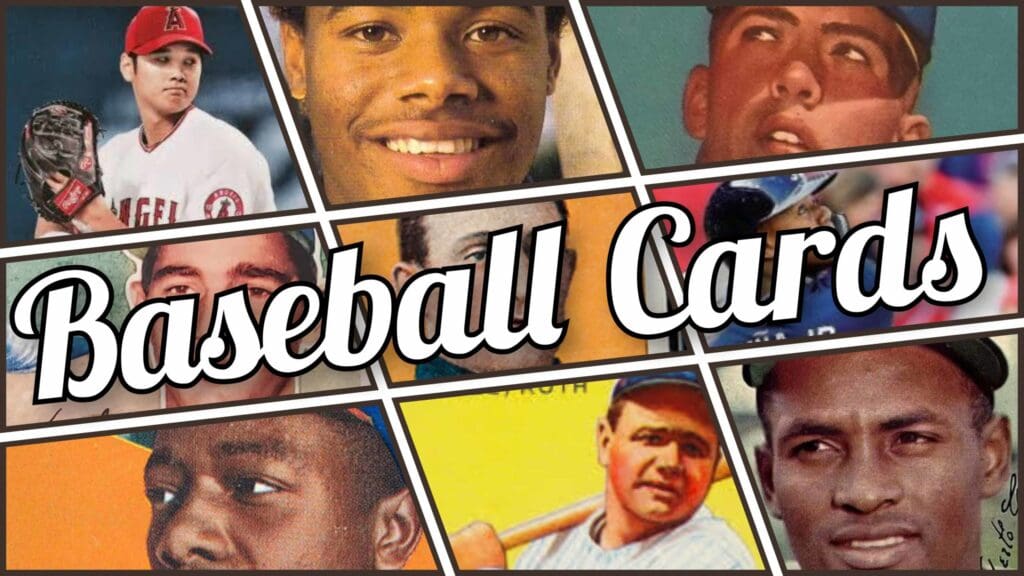
Pre-War Era
The pre-World War II era of collecting baseball cards holds a significant place in the history of the hobby. It was during this time that baseball cards gained popularity and became cherished collectibles for fans of the sport. Here's an overview of the pre-World War II era of collecting baseball cards:
Origins:
Baseball cards have their roots in the late 19th century. The first baseball cards were primarily used as promotional items, distributed by tobacco companies. Brands like Old Judge and Allen & Ginter issued cards featuring baseball players to encourage the purchase of their products.
Tobacco Cards:
Tobacco companies played a crucial role in the early days of baseball card production. Collectors could find cards included in cigarette packs or loose tobacco pouches. These cards were typically smaller in size, often measured around 2.5 x 1.5 inches. The designs were relatively simple, featuring player portraits, team logos, or generic baseball scenes.
Early Sets:
The 1909-1911 T206 set is one of the most iconic and sought-after collections from this era. It featured over 500 different player cards, including the famous Honus Wagner card, which is now considered one of the most valuable and rarest cards in existence. Other notable early sets include the 1887 N172 Old Judge and the 1914 Cracker Jack cards.
Candy and Gum Cards:
In the early 20th century, candy and gum manufacturers recognized the marketing potential of baseball cards. Companies such as Cracker Jack, Sweet Caporal, and Goudey Gum started producing cards to include in their products. These cards were often larger in size and showcased more elaborate designs, featuring vibrant colors and action poses of players.
Condition and Rarity:
Due to their intended use as promotional items, many early baseball cards were not preserved well. Most cards from this era have common issues like fading, creases, or damage. Additionally, cards were often discarded after use, making surviving examples rarer and more valuable.
Collecting Culture:
The pre-World War II era witnessed the emergence of a vibrant collecting culture. Baseball cards were initially collected by children, who would trade them with friends to complete sets or collect their favorite players. As time went on, adult collectors became more involved, recognizing the historical and nostalgic value of these cards.
Impact of World War II:
The outbreak of World War II had a significant impact on the production of baseball cards. The scarcity of resources and shifting priorities during the war led to a hiatus in card production. The hobby experienced a decline during this period, and it took some time to regain its popularity after the war.
The pre-World War II era of collecting baseball cards laid the foundation for the hobby's subsequent growth. The cards from this time period are highly prized by collectors due to their historical significance, scarcity, and the nostalgia associated with the early days of the sport.
POST-War Era
The post-World War II era marked a significant turning point in the history of collecting baseball cards. During this period, the hobby experienced a surge in popularity and transformed into a more organized and commercialized industry. Several factors contributed to this growth, including the emergence of new card manufacturers, changes in card designs and formats, and the increasing value of vintage cards.
Following World War II, the demand for baseball cards soared as the game regained its popularity and became deeply ingrained in American culture. This surge in interest prompted several companies to enter the baseball card market. Topps, Bowman, and Fleer were among the prominent manufacturers that produced baseball cards during this era. Topps, founded in 1938, became the dominant player in the industry and remains a major player today.
Card designs and formats also evolved during the post-war era. Early post-war cards, particularly those produced by Bowman, resembled the pre-war gum cards in terms of size and design. However, in 1952, Topps introduced its landmark 1952 Topps set, which featured larger, full-color cards and set the template for future baseball card designs. This set included the iconic Mickey Mantle rookie card, which has become one of the most valuable and sought-after cards in the hobby.
During this era, baseball card collecting became more mainstream, with many children and adults participating in the hobby. Trading cards became a popular pastime, with kids swapping duplicates and trying to complete their card sets. The cards themselves were often sold in packs containing a random assortment of cards, encouraging collectors to trade with friends to complete their collections.
The post-World War II era also saw the emergence of graded and professionally authenticated cards. In the 1990s, third-party grading companies like Professional Sports Authenticator (PSA) and Beckett Grading Services (BGS) began to assess and grade the condition of cards, providing collectors with a standardized system to evaluate card quality and authenticity. This development significantly impacted the market, as graded cards became highly desirable and commanded premium prices.
In terms of value, many vintage baseball cards from the post-World War II era have appreciated significantly over the years. High-grade examples of iconic rookie cards, such as Mickey Mantle, Willie Mays, and Hank Aaron, have become extremely valuable, often fetching prices in the hundreds of thousands or even millions of dollars at auction.
Overall, the post-World War II era marked a period of growth and transformation for baseball card collecting. The hobby became more commercialized, with new manufacturers entering the market and card designs evolving. Today, collecting baseball cards from this era continues to be a popular pastime, with a rich history and a wide range of valuable and cherished cards.
Junk Wax Era
The junk wax era refers to a period in baseball card collecting that spanned from the mid-1980s to the early 1990s. During this time, the production and popularity of baseball cards reached unprecedented levels, leading to a flood of cards on the market. The term "junk wax" is used to describe the excessive printing and overproduction of cards, resulting in an oversupply and diminished value.
Several factors contributed to the junk wax era. First, the popularity of baseball cards soared in the 1980s, driven by a growing interest in sports memorabilia and the emergence of new collectors. Card manufacturers, such as Topps, Donruss, and Fleer, saw an opportunity to capitalize on this trend and ramped up their production to meet the demand.
Another key factor was the change in card distribution methods. Previously, cards were mainly sold in packs, which added an element of unpredictability and rarity. However, during the junk wax era, manufacturers started flooding the market with complete sets, factory sets, and specialty products. This approach allowed collectors to easily obtain entire sets, diminishing the perceived scarcity and value of individual cards.
The mass production of baseball cards during this era led to overprinting on a massive scale. Card companies printed millions of cards of each player, resulting in a saturation of the market. Card shops, department stores, and even supermarkets were filled with countless boxes and packs of cards, making it difficult for collectors to distinguish valuable cards from common ones.
Additionally, card manufacturers introduced new techniques to increase sales, such as limited edition and special insert cards. However, even these cards became overproduced, diluting their value. Many collectors who had hoped to build valuable collections found themselves with cards that were worth far less than they had anticipated.
As a result of the overproduction, the value of most cards from the junk wax era plummeted. Cards that were once considered valuable, such as those of rookie players like Ken Griffey Jr., lost much of their worth. The market became saturated, and collectors found it challenging to sell their cards or even recoup their initial investments.
The junk wax era eventually came to an end as collectors and the industry recognized the oversupply issue. Card manufacturers adjusted their production levels, and new companies emerged with limited edition and high-end products, aiming to recapture the interest of collectors. Today, the junk wax era serves as a cautionary tale about the dangers of overproduction and the impact it can have on the value of collectibles.
The Modern Era
The modern era of baseball card collecting refers to the period from the late 20th century to the present day, characterized by significant changes and developments in the hobby. While traditional aspects of collecting, such as the appreciation of player cards and the thrill of building a complete set, still exist, the modern era has introduced new dynamics and trends.
Increased Production:
One of the defining features of the modern era is the mass production of baseball cards. Unlike earlier eras where cards were relatively limited in number, the modern era witnessed a surge in card production, leading to increased availability and lower individual card values. Major card manufacturers, such as Topps, Upper Deck, Panini, and Bowman, became more prominent, producing various sets and subsets each year.
Special Editions and Inserts:
To cater to collectors' interests, card manufacturers began introducing special edition sets and inserts. These could include autographed cards, relic cards (featuring pieces of game-worn jerseys or equipment), rookie cards, parallel cards (variations with different designs or foil accents), and other limited editions. These special cards often carry additional value and attract collectors seeking unique and rare pieces.
Grading and Authentication:
The modern era witnessed the rise of third-party grading and authentication services, such as Professional Sports Authenticator (PSA) and Beckett Grading Services (BGS). Collectors recognized the importance of card condition and authenticity, leading to the establishment of standardized grading systems. Graded cards are encapsulated in protective cases, providing assurance of their condition and enhancing their market value.
Online Marketplace and Trading:
The advent of the internet revolutionized the baseball card collecting hobby. Online platforms like eBay, COMC (Check Out My Cards), and various trading forums allowed collectors to buy, sell, and trade cards with ease. This expanded the reach of collectors beyond local communities, enabling them to connect with enthusiasts from around the world. Online marketplaces also facilitated the discovery of rare and hard-to-find cards.
Digital Collectibles:
Another notable development in the modern era is the emergence of digital collectibles. NFTs (non-fungible tokens) and blockchain technology have enabled the creation and trading of unique digital assets, including baseball cards. Digital cards offer collectors a new avenue for ownership and participation in the hobby, with the added benefit of enhanced portability and accessibility through digital platforms and marketplaces.
Focus on Player Performance and Analytics:
With the advent of advanced statistical analysis and increased focus on player performance metrics, collectors have become more interested in cards featuring standout players, rookies, and rising stars. Cards of players with exceptional statistics or those recognized as future stars often gain more attention and value in the modern era.
Social Media and Community Engagement:
Social media platforms like Instagram, Twitter, and Facebook have become significant channels for collectors to showcase their collections, discuss trends, and engage with the collecting community. Online forums, blogs, and podcasts dedicated to baseball card collecting have also flourished, fostering discussions, knowledge sharing, and building connections among collectors.
Diversification of Collecting:
While baseball cards remain a core focus, collectors in the modern era have also expanded their interests to include cards from other sports, entertainment, and popular culture. This diversification reflects the broader appeal of collecting and the integration of various interests within the hobby.
Overall, the modern era of baseball card collecting combines traditional elements with technological advancements and evolving trends. The hobby continues to evolve as collectors adapt to new formats, engage with digital platforms, and explore creative ways to connect with fellow enthusiasts.
